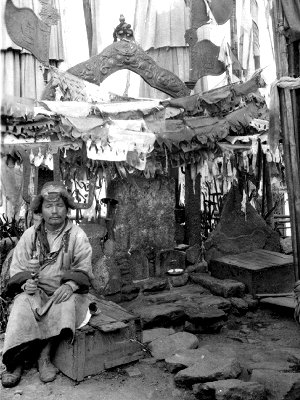Speculations on a broken Oath

The few Sikkimese still unhappy with the course history has taken in respect to their kingdom share a feeling that everything was arranged so nicely by the Buddhist saints: A people of brave blood brothers, a ruler vested with spiritual powers and, above all, mighty guardian deities spellbound to protect the land. So, what went wrong?
The assumption of a Long Chok being the precursor to the present Mahakal sanctuary at Observatory Hill in ancient times may suggest a plausible explanation if we allow our thoughts to float into the space of uncertainty. Let's speculate.
The monks of Pemayangtse did not establish a new outpost many a time, but they did so over the Dotsug/Long Chok at Observatory Hill.
Imagine: This must have been an eminent place of worship, then.
The deity venerated was likely a mighty one, one of prime importance to Lhopo and Rong alike. In a report on Observatory Hill written in 1912, Laden La mentioned that the Hindu folks "say they go there to worship Mahakal Baba. I don't know how they came to know that there is a Mahakal Baba on the top of Observatory Hill."
Imagine: The Hindu devotees were no fools, they came to know by analogy.
Powerful black guardian deities are not unique to the Hindu pantheon. Mahayana Buddhism knows several of them and the traditional beliefs of the Lepcha know at least one.
Imagine: This was the sanctum of Gyap Dut/Yabdud himself.
Gyap Dut, an ancient deity of the Rong, had been renamed Yabdud and taken under oath by Guru Rinpoche. Lhatsun Chenpo appointed him Guardian of the Southern Gate to the Buddhist Kingdom of Sikkim to ward off obstacles, disease, famine and war. Allegiance as defined by the supreme master was mutual, anyway, obligations were imposed on us humans as well. We have the sacred duty to worship the guardian with sincere veneration, and we are obliged to preserve and protect the sanctity of his abode and the shrines dedicated to him.
Imagine: We failed miserably.
When the Gorkha troops attacked Dotsug, we failed to protect its sacredness. We abandoned the place to its own fate and surrendered it to the vandalism of the invaders. May be, we even ran away. Such a breach of faith may have revoked the mutual obligations. Would this hold true, the whole misery that befell the kingdom, subsequently, would have followed a cruel logic:
The guardian deity offended, the southern gate abandoned, that flank lay open and vulnerable. There was easy access for the forces from the plains. And, in fact, it was from that direction the land was conquered, our kings were humiliated and independence was razed. While directing our attention to the threats allegedly looming in the North, they overran us from the South and no supernatural protector prevented them from doing so. Meanwhile, we paid lip service at Pang Lhabsol, every year, celebrating a bond we betrayed centuries ago, perhaps.
Even if such speculative apprehesions hold some truth, there may be hope. The pact was trilateral. If we're guilty of treason, Yabdud, still, owes allegiance to Guru Rinpoche. And so do we!
Driving our thoughts back from imagination to reality - and to a more introspective level - we could draw our conclusions. No doubt, British expansionism and Indira Gandhi's ruthless rule were a bane. But, don't we have our share in Sikkim's misery as well? Maybe, it's time for an appeal to all the pious Sikkimese ready to attend Pangtoe (meaning the real celebrations apart from that neo-creation resembling a carnival) in the days ahead: Remember your obligations, join the celebrations with a humble spirit and a sincere heart, worship our guardian deities with due veneration.
And let's learn from the mistakes possibly made in the past:
There are Long Choks yet blessed with immaculate sanctity that have to be preserved.
Chopel Serkhangpa, 4th September 2014
Illustration: Standing stones at Long Chok/Dotsug on Observatory Hill. The third in line is hidden behind the sitting devotee. Nowadays, the three stones are encased in a thick layer of Panchaloha (five-metal alloy). Photograph probably taken in the 1920s.
